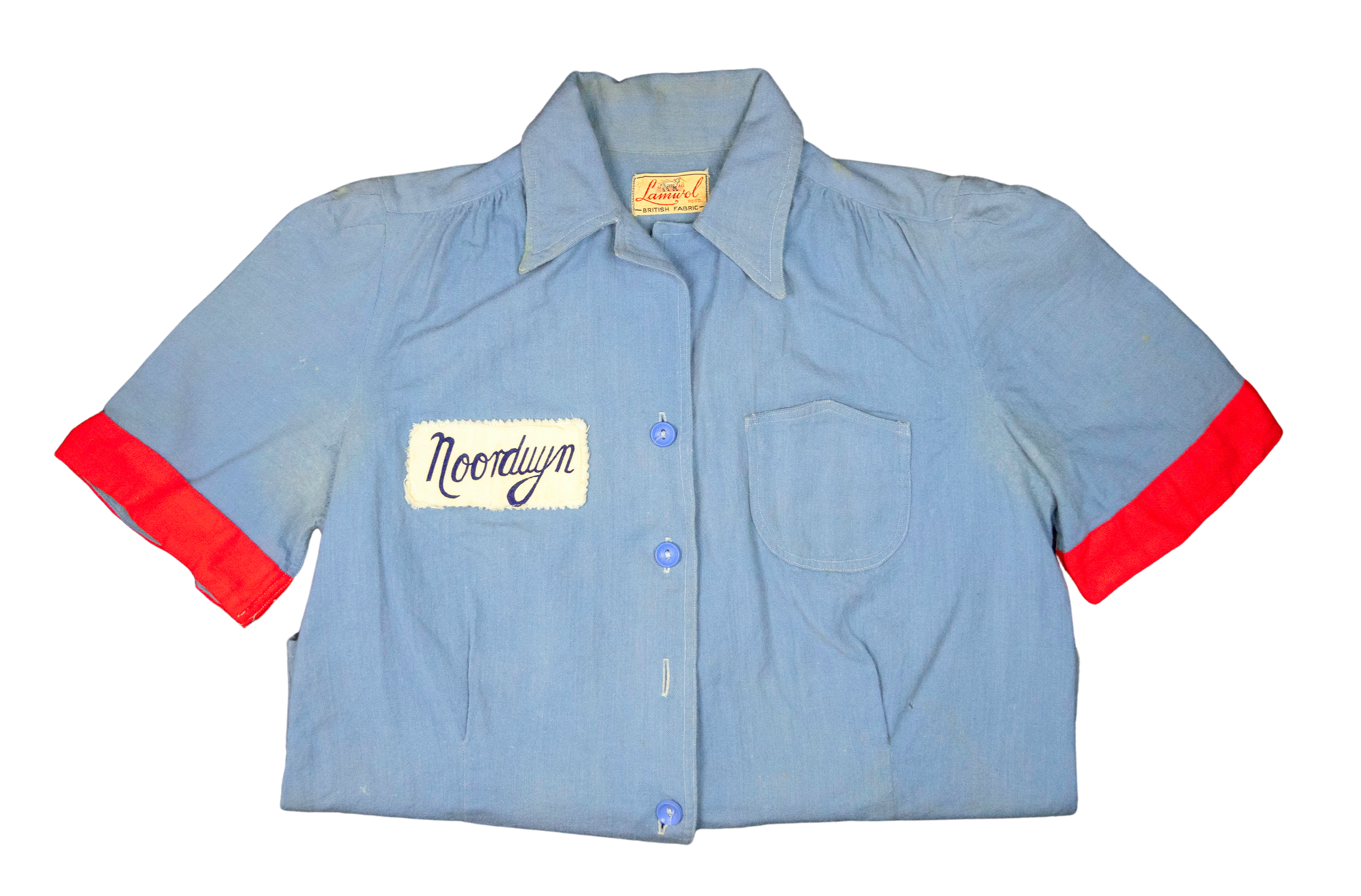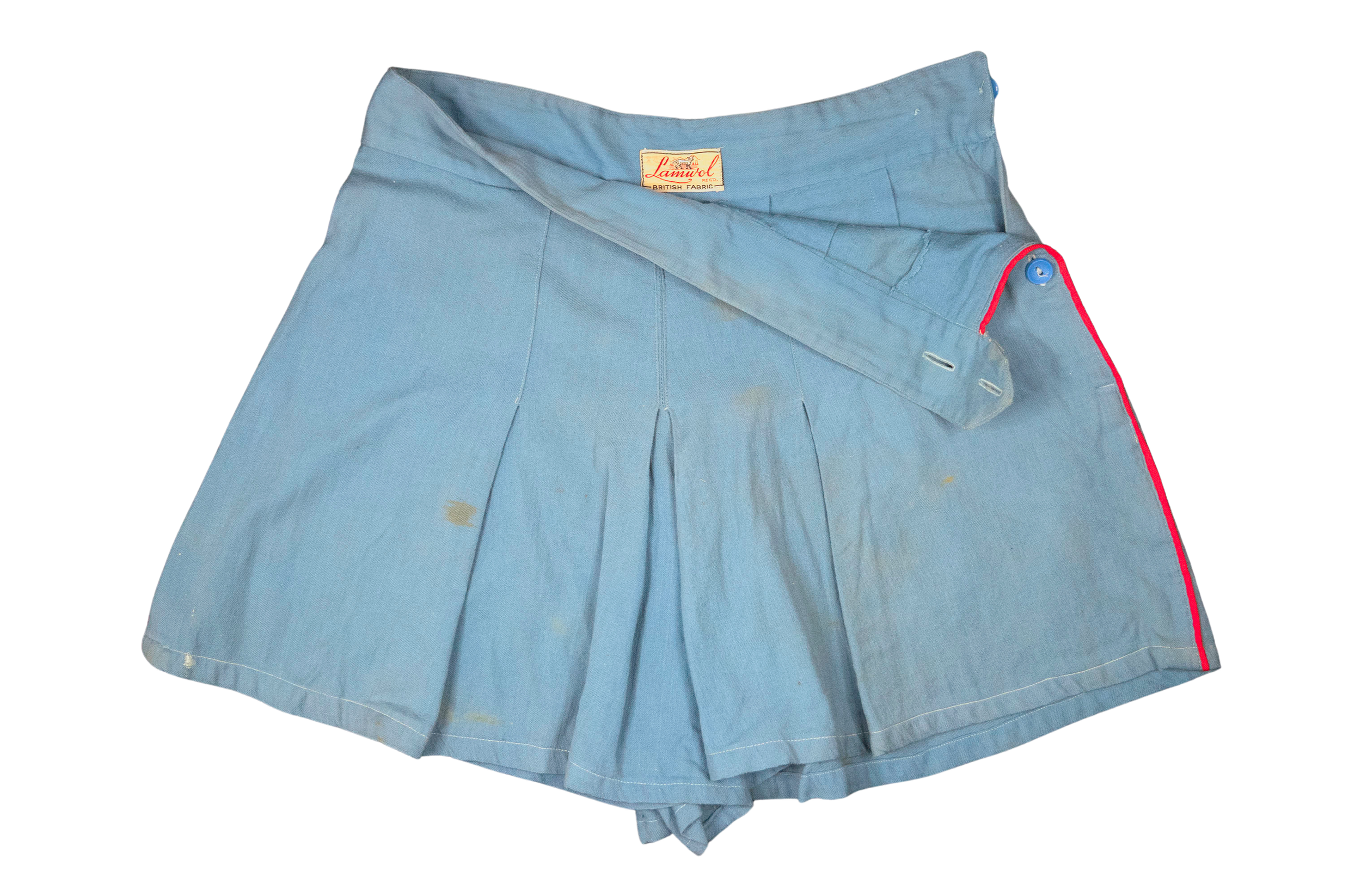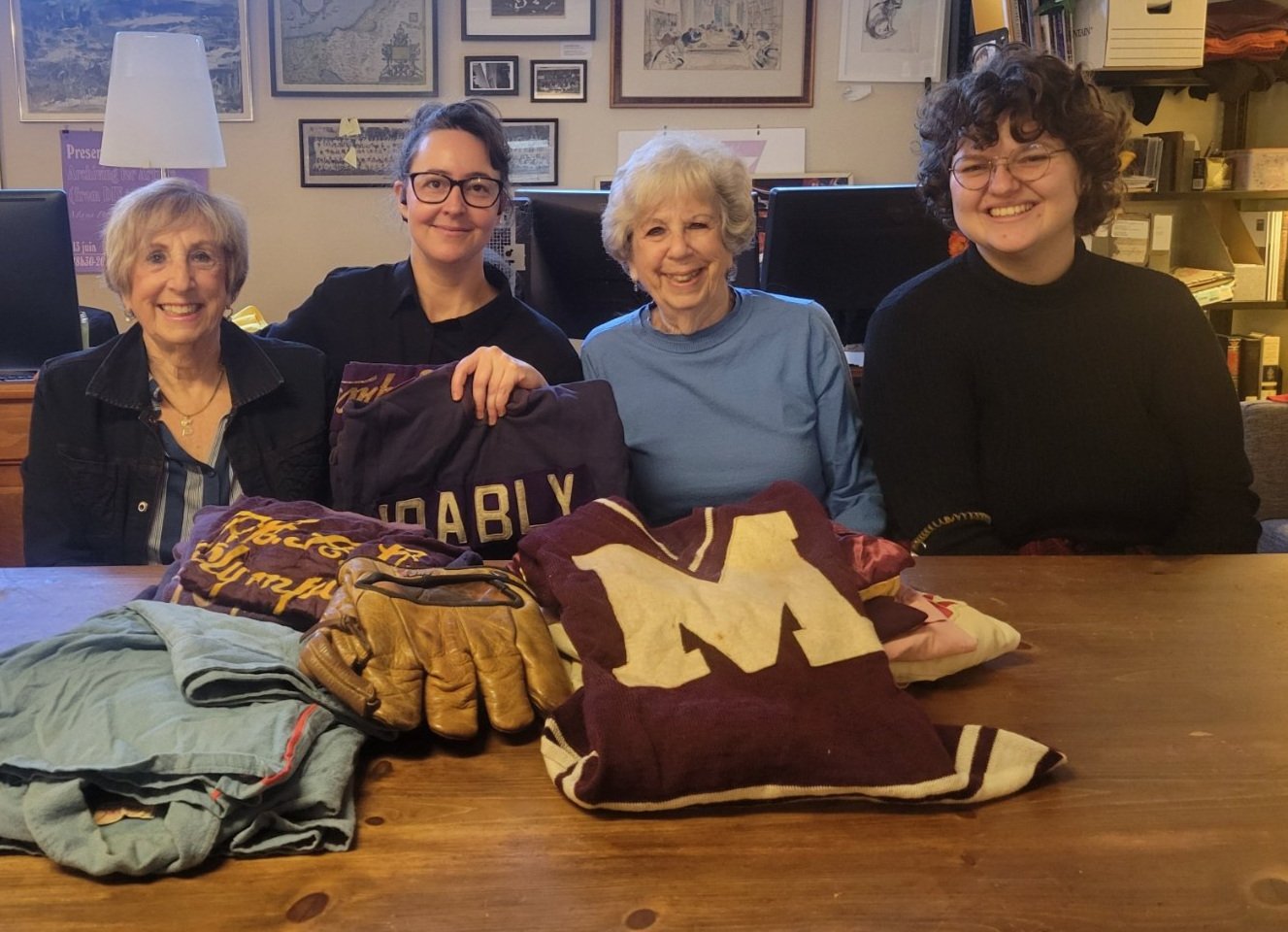TEAM
SPIRIT
The sporting days of
ida “wisey” Bly
IN-HOUSE EXHIBITION JULY 1 - OCTOBER 1, 2025
IDA “Wisey” BLY, 1915-1990
Born Ida Wiseberg in Sherbrooke, Quebec, in 1915, Bly graduated from Commercial High School in Montreal. Lovingly called “Wisey” by her teammates during the 1930s and 1940s, she was an athlete active in Montreal’s major women’s softball and basketball leagues. Known for her sportsmanship and team spirit as well as her determination on the court, she often led her team in points scored during games.
In newspaper articles covering her games on the Montreal Olympics basketball team, she was referred to as a “versatile forward,” “clever ball handler” and “deadly at the target”; she “emerged as the No. 1 star of the tilt” in a Men’s vs Women’s game fundraising for the Aid to Russia program in 1942, and was known to throw a “honey of a shot.” She played for Montreal’s All-Star Women’s team in an effort to dethrone the reigning world champions, the Edmonton Grads.
With her softball team, the Maroons, Bly traveled to New York City in 1938 to play a tournament at Madison Square Garden. In both her softball and basketball careers she won several provincial and regional championships; with her basketball team, The Olympics, she was a four-time Eastern Canada Championship winner. In 1945, The Olympics retired after winning their fifth Victory trophy, with Bly leaving her athletic career on a high note. She came out of retirement for a British Relief Fund game to shoot what Myrtle Cook highlighted was “one basket that was the prettiest of the entire game.”
Ida Bly in Maroons team softball uniform. Inscription on back reads: “Taken in St Jerome, September 3, 1933.” JPL Archives, Ida Bly Fonds, 1482_[1]_039
Olympics team members with a train, London, Ontario, April 15, 1945. Ida Bly is centre back row. JPL Archives, Ida Bly Fonds, 1482-1-[2]-053
Montreal women’s Olympics basketball team. Inscription on verso reads: “Winter of 1945, Senior champions. Helen Ovenden, Martha Kent, Gwen Grant, Joyce Griffin, Mona Hannay, Ida Bly, Mickey Ronnie, Eileen Hibbs. [Not pictured] Coach - Chuck Malis, Manager - Irene Wall.” 1945. JPL Archives, Ida Bly Fonds, 1482_[1]_076
WOMEN’s SPORTS IN THE
INTERWAR YEARS
Ida Bly’s sports career came at an interesting moment in history. The interwar years were “both exciting and challenging for women’s sports” and are woven together with the rich histories of women’s suffrage, emerging ideas of modern womanhood, and growing urbanism (Hall, 2016, p.xvi). During the First World War, many women stepped into roles that had previously never been open to them; sports and sports administration were no exception.
Born in 1915, Ida would have likely encountered basketball and softball in the 1920s, when they were already popular sports for high school girls (Hall, 2016, p.48). The Women’s Amateur Athletic Federation of Canada was formed in 1925 thanks to the determination of pioneering athlete and journalist Alexandrine Gibb. She felt strongly about women running their own sports, and this influence is visible when you look through the Executives list of the 1944 Montreal Ladies Basketball League, where women outnumber their male counterparts nine to one (Hall, 2016, p.48 and 1482_[1]_001).
An important feature about both of Ida Bly’s chosen sports, basketball and softball, is that they require very little equipment, making them quite cheap to play: an important characteristic for a passtime during a depression like the 1930s. The Great Depression also saw under-employed players lured to new cities with the promise of playing sports and writing sports columns, like Fannie “Bobbie” Rosenfeld moving from Toronto to Montreal in 1932 (Hall, 2016, p.146). Around this time, “companies encouraged team managers and coaches to scout for softball talent in neighbouring villages and towns by offering factory employment in exchange for skill on the field” (Hall, 2016, p.97).
Ida Bly’s success in sports was during a time when a husband’s disapproval meant leaving sports for many athletes, and when some leagues had to grant married players permission to join teams (Hall, 2016, p.140). Her husband, Max Bly, supported her athleticism, taking turns with his wife minding their children so that both could participate in sports.
During the Second World War, when men’s sports teams were temporarily shut down, women’s and co-ed fundraiser games were commonplace to support the war effort and to entertain troops at home. In the Ida Bly Fonds we find reference to an Aid to Russia game and a British Relief game. A similar, fictionalized history is portrayed in the 1992 Hollywood film “A League of Their Own,” based on the All-American Girls Professional Baseball League.
“… the history of women in sport is a history of cultural resistance.”
Playing Schedules (first spread), Montreal Ladies' Basketball League, 1944. JPL Archives, Ida Bly Fonds, 1482-1-[4]-001
Newspaper article on the Olympics winning a “girls vs boys” match over the Y.W.H.A team, 40-35. Ida Bly “emerged the No. 1 star” for her 18 points. February 9, 1942. JPL Archives, Ida Bly Fonds, 1482-1-[1]-023
"Four of the girls chosen for Montreal All-Stars basketball players in August, 1934. Millie Jack, Ida Wiseberg, Millie Feather, Betty Charles." Inscription written by Ida Bly. JPL Archives, Ida Bly Fonds, 1482-1-[2]-061
Ida Bly's registration cards for the Women's Amateur Athletic Federation of Canada for the Olympics basketball team. JPL Archives, Ida Bly Fonds, 1482-1-[4]-086, 087, 088, 089
Portrait of three of the Maroons softball players. JPL Archives, Ida Bly Fonds, 1482-1-[2]-064
JEWS AND BASKETBALL
“By the process of elimination, then, Basket Ball became the athletic endeavor most favored by thousands of young Jews living in New York City. Besides, the game was frenetic and required quick thinking, rapidity of movement, and endurance—making it the perfect urban sport.”
Jews and basketball have gone hand in hand since nearly the beginning. Basketball was invented in 1891 as a Young Men’s Christian Association (YMCA) program by Canadian physical education instructor James Naismith, and quickly spread across North America and internationally. It was particularly popular in urban settings and places with cold winters, where access to fields required for other sports was limited for all or part of the year. By 1920, nearly half of all Jews living in the United States were in New York City (Rosen, 2017, p.3). Young Men’s Hebrew Associations (YMHAs) had been established in New York since 1874, and encouraged their members to balance athletics and morality, pushing sports to newly arrived immigrants with the goal of combatting increasing antisemitic stereotypes that Jews were overly intellectual and weak (Rosen, 2017, p.4). In the Northeastern United States, early men’s basketball was dominated by Jewish players, who found in the sport an outlet for their athletic interests. Many other sports were not available to them, since the privately owned facilities of other sports were only open to Gentile members (Rosen, 2017, p.3).
In many cities across North America, religious associations such as the YMCA/YWCA, YMHA/YWHA, and SPHA (South Philadelphia Hebrew Association) were the nascent grounds for sports like basketball before they expanded into their own leagues. In Montreal, the YWHA and YMHA were both founded in 1910, and were growing in membership by the 1920s, when Ida’s sporting career began. Newspaper clippings she kept in her scrapbook indicate that she was a “former YWHA star,” but she is more often listed as playing against the YWHA while representing the municipally organized NDG team and later, the Olympics (1482-1-[1]-002).
Portrait of the Montreal All-Stars basketball team featured in the Keneder Adler (Daily Eagle) Yiddish Newspaper. August, 1934. JPL Archives, Ida Bly Fonds, 1482-1-[1]-005
Montreal Ladies Basketball League Trophy awarded to Ida Bly and teammates, 1934-1935. JPL Archives, Ida Bly Fonds, 1482-2-[2]-003
"In the Women's Sportlight" by Myrtle Cook, circa 1940s. In the lead up to a notice about an upcoming game, Cook details Ida's spectacular career and team spirit. JPL Archives, Ida Bly Fonds, 1482-1-[1]-002
FAMOUS CONTEMPORARIES
At face value, the Ida Bly Fonds is a beautifully concise capsule of one woman’s athletic career in team sports. The more time you spend with the material, however, the more you start to notice the names of teammates, coaches, managers, and the journalists who covered them in the major papers. Numerous people in Ida Bly’s sporting circles were Olympians, future Hall of Famers, or world champions. Her materials get more exciting the more you read. Here are the stories of a few of those names.
It’s safe to assume that Bly played against the famous Rosenfeld, given the time period they were both playing in Montreal. Rosenfeld is known as one of the “Matchless Six”: a medal-winning Olympian from the 1928 Summer Olympics, the first year that women were allowed to compete in track and field. She was also an exceptional basketball, hockey, and softball player. When she retired from competing, she didn’t retire from sports; her brief stint in Montreal was the start of her sports journalism career at the Montreal Daily Herald. She was involved in founding the Provincial Women’s Softball Union of Quebec and serving as its first president before returning to Toronto. Starting in 1936, she maintained a 20-year long column called “Sports Reel” in The Globe and Mail. She was a strong critic of those who argued that sports made women unfeminine. Rosenfeld was inducted into Canada’s Sports Hall of Fame in 1955.
In covering Ida Bly’s team’s games, Olympic champion and pioneering sports journalist Myrtle Cook-McGowan often singled out Bly as a “versatile forward,” “clever ball handler” and “deadly at the target” over many years of covering her team in her long-running Montreal Star column, “In the Women’s Sport Light.” Her column dedicated to women’s sports ran for more than 40 years. Before this phenomenal career, however, Myrtle Cook-McGowan was a 1928 Olympian alongside Bobbie Rosenfeld, one more of the infamous “Matchless Six,” winning a gold medal alongside Rosenfeld, Jane Bell and Ethel Smith for 4 x 100 meter race with a record time of 48.4 seconds.
The Edmonton Grads are, by several measures, one the best sports teams the world has ever seen, and most of us have never heard of them. In their short 25 years, they won more than 96% of their 522 games: a higher record than teams that many consider to be the greatest, like the 1983-84 Edmonton Oilers, or the 2015-16 Golden State Warriors. They were National Champions for 19 years, North American Champions for 17 years, and reigning World Champions for 16 years (Edmonton Grads, 1975).
Ida Bly played against them three times in her career, for the All-Stars and the Olympics; in August 1934, they played to a crowd of over 2,500 people at Montreal’s Forum. The Grads won that game 63-6.
Newspaper portrait of the Olympics and an article about the upcoming Victory trophy. Ida Bly is second from right in the front row. JPL Archives, Ida Bly Fonds, 1482-1-[1]-030
Portrait of Ida Bly taken in August, 1934, on the occasion of being chosen to play on the Montreal Allstars team against the Edmonton Grads. JPL Archives, Ida Bly Fonds, 1482-1-[2]-060
"In the Women's Sportlight" by Myrtle Cook from April 6, 1936. It details the Eastern Canada Final basketball match between N.D.G and Windsor, for which Irene Wall bought four tickets. It also mentions the engagement of Ida Wiseberg and Max Bly. JPL Archives, Ida Bly Fonds, 1482-1-[1]-007
Women’s Sportswear
“We smilingly admit that our get-up wasn’t exactly what fashion might decree—but what was a gal to do? With unflagging effort we tried all over town to purchase raiment in accordance with what the best-dressed sprinter was wearing, so that we could discard our modesty-preserving pup-tent bloomers, spinnaker middy and hip-length stockings. But girl athletes were as yet in the neophyte stage, and sporting goods houses proved an absolute blank... so we had to improvise our new and less blush-saving garments... And anyway they got us there, even if they didn’t exemplify the ultimate in art and good taste.”
In a little over a hundred years, women’s sportswear has come leaps and bounds, although discussions about femininity and modesty have remained part of the conversation. Early women’s baseball teams at the turn of the century had names like the Chicago Blackstockings, the Boston Bloomer Girls, and the Star Bloomer Girls; clearly what they wore played a role. This was a time before companies were making clothing specifically designed for sports. By the 1920s, one softball team out of Red Deer Hill were called the “Pyjama Girls” because the only uniforms they could find that were comfortable enough to play in within their price point were cotton pyjamas from an Eaton’s catalogue (Hall, 2016, p. 98).
The interwar period saw some of the first huge shifts in softball and basketball, right around when Ida Bly was getting her start. Images of the Edmonton Grads basketball team in 1923 show them wearing long, loose sailor-style middy blouses and shorts to mid-thigh, with knit socks that reach almost as high as their shorts. By 1926 they were wearing what would today be considered ‘short shorts and tight t-shirts, similar to the styles of Ida Bly’s uniforms in our collection.
The fabric available for sports clothing did not include the moisture-wicking options we often choose today, although new inventions in synthetic materials and blends were being experimented with for sports gear. Many sports uniforms of Ida Bly’s era were made of rayon blends, or wool and cotton blends. Another notable point is that many of the uniforms in Ida’s collection are handmade, or home-altered.

Blue and red wool short sleeve shirt, part of three-piece softball uniform. Paramount team with Noordwyn sponsorship. 1940s. JPL Archives, Ida Bly Fonds, 1482-TBP

Blue wool skort, part of three-piece softball uniform. Paramount team with Noordwyn sponsorship. 1940s. JPL Archives, Ida Bly Fonds, 1482-TBP
IDA BLY OFF THE COURT
Ida Bly retired from organized sports while her daughters were still young, but never lost the competitive drive. She was known to join a pickup game and play baseball with her grandchildren into her 60s. She was an avid bicycle rider long before it was popular for women here; she bowled weekly and was an avid poker player. Outside of sports and games, she followed a career as an office manager for an electrical contracting company in Montreal, where the owners loved her for all the same reasons that made her a good teammate. She was always busy, especially when at the cottage up north when her grandchildren were little. Her door was always open, her freezer always full for loved ones who were stopping by, and she lovingly baked poppyseed cookies like her mother before her. Ida Bly passed away in 1990. Her daughters, Sandra, Leona and Beverley donated their mother’s sports memorabilia to the JPL Archives in 2024. The fonds was processed by McGill Practicum student Kat Bochler in the winter 2025 semester.
Polaroid photograph of members of the Olympics basketball team around a table taken at a team reunion in October 1974. Ida Bly is second from left in the back row. JPL Archives, Ida Bly Fonds, 1482-1-[2]-079
Newspaper article where Ida Bly came out of retirement to play a “girls vs boys” basketball match and scored the “prettiest” basket of the game. Date unknown, 1940s. JPL Archives, Ida Bly Fonds, 1482-1-[1]-037

Leona Sternfeld and Sandra Shadowitz donating the sports uniforms worn by their mother, Ida Bly, to her archival collection. Accompanied by Maya Pasternak and Sam Pappas of the JPL Archives. November 7, 2024

Curator Ellen Belshaw with Sandy Shadowitz and Leona Sternfeld at the finissage of the exhibition on September 30, 2025.

Installation view of the physical exhibition, September 2025.
TO LEARN MORE:
Ida Bly Fonds, JPLArchives.org
Edmonton Grads: 25 years of Basketball Champions, 1915-1940
The World’s Greatest Sports Team: The Edmonton Grads | City of Edmonton
The Chosen Game: A Jewish Basketball History by Charley Rosen
Myrtle Cook | Canada’s Sports Hall of Fame
The Girl and the Game: A History of Women’s Sport in Canada by M. Ann Hall
Content written and curated by Ellen Belshaw. Special thanks to Kat Boechler, 2025 Winter Practicum student for her thoughtful, hard work in processing the Ida Bly Fonds. You can read about Kat’s work in her For the Record blog post.
The physical companion for this exhibition runs from July 1 — October 1, 2025.
The Ida Bly Fonds was acquired by the JPL Archives in 2024 thanks to the gracious donation of her daughters, Sandra Shadowitz, Leona Sternfeld and Beverley Bly who we thank for their valuable consultative contributions in the preparation and maintenance of this exhibition.



![Ida Bly in Maroons team softball uniform. Inscription on back reads: “Taken in St Jerome, September 3, 1933.”
JPL Archives, Ida Bly Fonds, 1482_[1]_039](https://images.squarespace-cdn.com/content/v1/62b48292d1bcbc071b15094c/1751307750846-RSOHIT3XG2GRBB4HPF9B/1.jpg)
![Olympics team members with a train, London, Ontario, April 15, 1945. Ida Bly is centre back row. JPL Archives, Ida Bly Fonds, 1482-1-[2]-053](https://images.squarespace-cdn.com/content/v1/62b48292d1bcbc071b15094c/1751307803265-N3M59V55YY35WL4ZUR4K/10.jpg)
![Montreal women’s Olympics basketball team. Inscription on verso reads: “Winter of 1945, Senior champions. Helen Ovenden, Martha Kent, Gwen Grant, Joyce Griffin, Mona Hannay, Ida Bly, Mickey Ronnie, Eileen Hibbs. [Not pictured] Coach - Chuck Malis, Ma](https://images.squarespace-cdn.com/content/v1/62b48292d1bcbc071b15094c/1751307876688-DPFZGD9RWBQIK9A43MF0/2.jpg)
![Playing Schedules (first spread), Montreal Ladies' Basketball League, 1944.
JPL Archives, Ida Bly Fonds, 1482-1-[4]-001](https://images.squarespace-cdn.com/content/v1/62b48292d1bcbc071b15094c/1751308629816-IUIXOOU43WNYI6GX263A/7.jpg)
![Newspaper article on the Olympics winning a “girls vs boys” match over the Y.W.H.A team, 40-35. Ida Bly “emerged the No. 1 star” for her 18 points. February 9, 1942. JPL Archives, Ida Bly Fonds, 1482-1-[1]-023](https://images.squarespace-cdn.com/content/v1/62b48292d1bcbc071b15094c/1751484830787-B6CY49648HHGD0GJ2776/3.jpg)
!["Four of the girls chosen for Montreal All-Stars basketball players in August, 1934. Millie Jack, Ida Wiseberg, Millie Feather, Betty Charles." Inscription written by Ida Bly. JPL Archives, Ida Bly Fonds, 1482-1-[2]-061](https://images.squarespace-cdn.com/content/v1/62b48292d1bcbc071b15094c/1752082076265-8M1J8QHQ3M7LJBDY5SGK/1482_%255B1%255D_061_smaller.jpg)
![Ida Bly's registration cards for the Women's Amateur Athletic Federation of Canada for the Olympics basketball team. JPL Archives, Ida Bly Fonds, 1482-1-[4]-086, 087, 088, 089](https://images.squarespace-cdn.com/content/v1/62b48292d1bcbc071b15094c/1751308182585-J19K88CKE8OBBS4HFW7O/12.jpg)
![Portrait of three of the Maroons softball players. JPL Archives, Ida Bly Fonds, 1482-1-[2]-064](https://images.squarespace-cdn.com/content/v1/62b48292d1bcbc071b15094c/1752081650894-67M70JXP827VS4DASQN8/6.jpg)
![Portrait of the Montreal All-Stars basketball team featured in the Keneder Adler (Daily Eagle) Yiddish Newspaper. August, 1934. JPL Archives, Ida Bly Fonds, 1482-1-[1]-005](https://images.squarespace-cdn.com/content/v1/62b48292d1bcbc071b15094c/2a83bb20-de66-4e7b-a562-b4fa391ee402/14.png)
![Montreal Ladies Basketball League Trophy awarded to Ida Bly and teammates, 1934-1935. JPL Archives, Ida Bly Fonds, 1482-2-[2]-003](https://images.squarespace-cdn.com/content/v1/62b48292d1bcbc071b15094c/1752158128533-PQ4QF76TWYF46LH505VY/1482_002a.jpg)
!["In the Women's Sportlight" by Myrtle Cook, circa 1940s. In the lead up to a notice about an upcoming game, Cook details Ida's spectacular career and team spirit. JPL Archives, Ida Bly Fonds, 1482-1-[1]-002](https://images.squarespace-cdn.com/content/v1/62b48292d1bcbc071b15094c/d6f7fa46-a97c-4f5f-894c-ed7d6ebaa3b4/2025_IdaBlyExhibition_TV.png)
![Newspaper portrait of the Olympics and an article about the upcoming Victory trophy. Ida Bly is second from right in the front row. JPL Archives, Ida Bly Fonds, 1482-1-[1]-030](https://images.squarespace-cdn.com/content/v1/62b48292d1bcbc071b15094c/1751310479942-DXMU88XDCA7GN7GDR865/15.jpg)
![Portrait of Ida Bly taken in August, 1934, on the occasion of being chosen to play on the Montreal Allstars team against the Edmonton Grads. JPL Archives, Ida Bly Fonds, 1482-1-[2]-060](https://images.squarespace-cdn.com/content/v1/62b48292d1bcbc071b15094c/1751310671268-HZ6XR4OA1PLU09X1C7HG/17.jpg)

![Polaroid photograph of members of the Olympics basketball team around a table taken at a team reunion in October 1974. Ida Bly is second from left in the back row. JPL Archives, Ida Bly Fonds, 1482-1-[2]-079](https://images.squarespace-cdn.com/content/v1/62b48292d1bcbc071b15094c/dd90cab1-6328-4470-a738-7c1a5ca8509d/13.png)
![Newspaper article where Ida Bly came out of retirement to play a “girls vs boys” basketball match and scored the “prettiest” basket of the game. Date unknown, 1940s.
JPL Archives, Ida Bly Fonds, 1482-1-[1]-037](https://images.squarespace-cdn.com/content/v1/62b48292d1bcbc071b15094c/1751310724614-Y2E9RBSO3R7YRAZRV7FC/5.jpg)